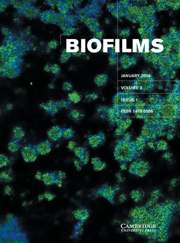Crossref Citations
This article has been cited by the following publications. This list is generated based on data provided by
Crossref.
Jesus, B.
Perkins, R. G.
Mendes, C. R.
Brotas, V.
and
Paterson, D. M.
2006.
Chlorophyll fluorescence as a proxy for microphytobenthic biomass: alternatives to the current methodology.
Marine Biology,
Vol. 150,
Issue. 1,
p.
17.
Guzzon, Antonella
Bohn, Andreas
Diociaiuti, Marco
and
Albertano, Patrizia
2008.
Cultured phototrophic biofilms for phosphorus removal in wastewater treatment.
Water Research,
Vol. 42,
Issue. 16,
p.
4357.
Jesus, B.
Brotas, V.
Ribeiro, L.
Mendes, C.R.
Cartaxana, P.
and
Paterson, D.M.
2009.
Adaptations of microphytobenthos assemblages to sediment type and tidal position.
Continental Shelf Research,
Vol. 29,
Issue. 13,
p.
1624.
Perkins, R. G.
Kromkamp, J. C.
Serôdio, J.
Lavaud, J.
Jesus, B.
Mouget, J. L.
Lefebvre, S.
and
Forster, R. M.
2010.
Chlorophyll a Fluorescence in Aquatic Sciences: Methods and Applications.
p.
237.
Salleh, Sazlina
and
McMinn, Andrew
2011.
THE EFFECTS OF TEMPERATURE ON THE PHOTOSYNTHETIC PARAMETERS AND RECOVERY OF TWO TEMPERATE BENTHIC MICROALGAE, AMPHORA CF. COFFEAEFORMIS AND COCCONEIS CF. SUBLITTORALIS (BACILLARIOPHYCEAE)1.
Journal of Phycology,
Vol. 47,
Issue. 6,
p.
1413.
Salleh, Sazlina
and
McMinn, Andrew
2011.
Photosynthetic response and recovery of Antarctic marine benthic microalgae exposed to elevated irradiances and temperatures.
Polar Biology,
Vol. 34,
Issue. 6,
p.
855.
Jodłowska, S.
and
Latała, A.
2013.
Combined effects of light and temperature on growth, photosynthesis, and pigment content in the mat-forming cyanobacterium Geitlerinema amphibium.
Photosynthetica,
Vol. 51,
Issue. 2,
p.
202.
Le, Chengfeng
Hu, Chuanmin
English, David
Cannizzaro, Jennifer
and
Kovach, Charles
2013.
Climate-driven chlorophyll-a changes in a turbid estuary: Observations from satellites and implications for management.
Remote Sensing of Environment,
Vol. 130,
Issue. ,
p.
11.
Kesaano, Maureen
and
Sims, Ronald C.
2014.
Algal biofilm based technology for wastewater treatment.
Algal Research,
Vol. 5,
Issue. ,
p.
231.
Jodłowska, S.
and
Śliwińska, S.
2014.
Effects of light intensity and temperature on the photosynthetic irradiance response curves and chlorophyll fluorescence in three picocyanobacterial strains of Synechococcus.
Photosynthetica,
Vol. 52,
Issue. 2,
p.
223.
Saunders, P.
Rogerson, M.
Wadhawan, J.D.
Greenway, G.
and
Pedley, H.M.
2014.
Mg/Ca ratios in freshwater microbial carbonates: Thermodynamic, kinetic and vital effects.
Geochimica et Cosmochimica Acta,
Vol. 147,
Issue. ,
p.
107.
Firstater, FN
Narvarte, M
Alvarez, MF
Fanjul, ME
and
Iribarne, OO
2016.
Cordgrass canopy elicits weak effects on sediment properties and microphytobenthic abundance in a harsh environment.
Marine Ecology Progress Series,
Vol. 550,
Issue. ,
p.
101.
Talaiekhozani, Amirreza
and
Rezania, Shahabaldin
2017.
Application of photosynthetic bacteria for removal of heavy metals, macro-pollutants and dye from wastewater: A review.
Journal of Water Process Engineering,
Vol. 19,
Issue. ,
p.
312.
Pennesi, Chiara
and
Danovaro, Roberto
2017.
Assessing marine environmental status through microphytobenthos assemblages colonizing the Autonomous Reef Monitoring Structures (ARMS) and their potential in coastal marine restoration.
Marine Pollution Bulletin,
Vol. 125,
Issue. 1-2,
p.
56.
Lee, Kok-Keong
Lim, Phaik-Eem
Poong, Sze-Wan
Wong, Chiew-Yen
Phang, Siew-Moi
and
Beardall, John
2018.
Growth and photosynthesis of Chlorella strains from polar, temperate and tropical freshwater environments under temperature stress.
Journal of Oceanology and Limnology,
Vol. 36,
Issue. 4,
p.
1266.
Pniewski, Filip
and
Sylwestrzak, Zuzanna
2018.
Influence of short periods of increased water temperature on species composition and photosynthetic activity in the Baltic periphyton communities.
Biologia,
Vol. 73,
Issue. 11,
p.
1067.
Sadatshojaei, Erfan
Mowla, Dariush
and
Wood, David A.
2020.
Sustainable Green Chemical Processes and their Allied Applications.
p.
539.
Tolhurst, Trevor J.
Chapman, M. G.
and
Murphy, R. J.
2020.
The Effect of Shading and Nutrient Addition on the Microphytobenthos, Macrofauna, and Biogeochemical Properties of Intertidal Flat Sediments.
Frontiers in Marine Science,
Vol. 7,
Issue. ,
Salleh, Sazlina
and
McMinn, Andrew
2021.
Tolerance of tropical marine microphytobenthos exposed to elevated irradiance and temperature.
Biogeosciences,
Vol. 18,
Issue. 19,
p.
5313.
Srivastava, Kanishka
Singh, Sweta
Singh, Meenakshi
Parabia, Farzin
and
Chandrasekhar, K.
2022.
Application of Biofilms in Applied Microbiology.
p.
203.


